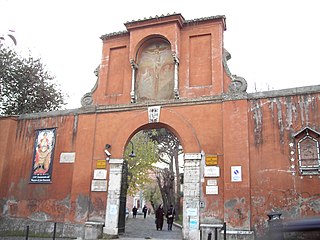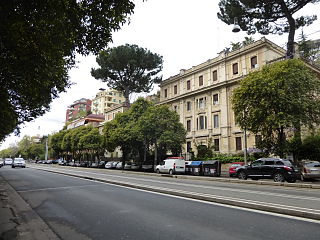Related Research Articles

Albano Laziale is a comune (municipality) in the Metropolitan City of Rome Capital, on the Alban Hills, in the Italian region of Lazio. Rome is 25 kilometres (16 mi) distant. It is bounded by other communes of Castel Gandolfo, Rocca di Papa, Ariccia and Ardea. Located in the Castelli Romani area of Lazio. It is sometimes known simply as Albano.

The Villa Doria Pamphili is a seventeenth-century villa with what is today the largest landscaped public park in Rome, Italy. It is located in the quarter of Monteverde, on the Gianicolo, just outside the Porta San Pancrazio in the ancient walls of Rome where the ancient road of the Via Aurelia commences.

Nereus and Achilleus are two Roman martyr saints. In the present General Roman Calendar, revised in 1969, Nereus and Achilleus (together) are celebrated on 12 May.

The basilica of San Pancrazio is a Catholic minor basilica and titular, conventual, and parish church founded by Pope Symmachus in the 6th century in Rome, Italy. It stands in via S. Pancrazio, westward beyond the Porta San Pancrazio that opens in a stretch of the Aurelian Wall on the Janiculum and covers the Catacomb of San Pancrazio. The adjacent convent was established perhaps as early as the church and has been occupied by the Discalced Carmelite since 1662.

The Catacomb of Saint Agnes is one of the catacombs of Rome, placed at the second mile of via Nomentana, inside the monumental complex of Sant'Agnese fuori le mura, in the Quartiere Trieste.
The Catacombs of San Valentino is one of the catacombs of Rome (Italy), placed at the 2nd mile of the via Flaminia, now in Viale Maresciallo Pilsudski, in the modern Pinciano neighborhood.

The Catacomb of San Pancrazio is a catacomb of Rome (Italy), located in the Via Aurelia, within the modern Quartiere Gianicolense.

The following outline is provided as an overview of and topical guide to Rome:

Gianicolense is the 12th quartiere of Rome (Italy), identified by the initials Q. XII. It belongs to the Municipio XI and Municipio XII. It takes its name from the Janiculum hill, which lies in the nearby rione Trastevere and whose western extremities correspond to the area of Monteverde.
The Catacomb of Sant' Ermete or Catacomb of Bassilla is a catacomb on the former via Salaria in Rome, now sited in the Pinciano district on via Berolini. It originated some time between 200 and 250.

The Catacomb of Santi Marco e Marcelliano is a catacomb between the ancient via Appia antica and via Ardeatina in what is now the Ardeatino district of Rome. With the catacomb of Callixtus and the Catacomb of Balbina, it is one of three catacombs in the Callixtian Complex between the via Appia antica, via Ardeatina and vicolo delle Sette Chiese.
The Catacomb of the Two Felixes is a catacomb on the ancient via Aurelia in Rome, run by the Pontifical Commission for Sacred Archaeology. Its ancient name is unknown but the Notitia ecclesiarum urbis Romae states of a catacomb near those of San Pancrazio and Santi Processo e Martiniano "and you ascend above and you will reach the church; there Saint[s] Martianus and Processus rest under the earth, and saint Lucina, virgin and martyr, in the upper part; then you will reach by the same via [Aurelia] the two martyred holy pontiffs both named Felix".
The ad Clivum Cucumeris Catacomb was one of the catacombs of Rome, sited on the ancient via Salaria according to ancient sources but not yet conclusively identified with any surviving ancient remains.

The Catacomb of Sant'Ippolito is a catacomb on the via Tiburtina in Rome, now entered from via dei Canneti in the modern Nomentano quartiere.

The Catacomb of Santi Gordiano e Epimaco is a catacomb on the ancient via Latina in Rome, near the Aurelian Wall and piazza Galeria in the Appio-Latino quarter. Only some of its galleries have been found and excavated - archaeologists believe it to be a much larger necropolis on several levels, with inscriptions from Julian's reign showing it to have still been in use at that date.
The Catacomb of San Panfilo is one of the catacombs of Rome, sited under via Paisiello and via Spontini in the Pinciano quarter and along the line of the ancient route of the via Salaria. It is named after the Carthaginian martyr Pamphilus. The modern-day entrance is in Santa Teresa del Bambin Gesù in Panfilo. The ancient sources identify it as the first catacomb on the via Salaria starting from porta Pinciana.

The Catacomb of San Nicomede was a catacomb at the start of the via Nomentana near the modern Porta Pia in the Nomentano quarter, though its precise location is still unknown.
The Catacomb of San Lorenzo or Catacomb of Cyriaca is a five-level catacomb on via Tiburtina under the church of San Lorenzo fuori le mura in the modern Tiburtino quarter.
The Catacomb of Trasone is a catacomb on the left side of the ancient via Salaria, at its junction with via Yser, in the modern-day Parioli quarter of Rome. Begun in the 3rd century, is named after Trason or Thrason, a rich Christian Roman citizen under Diocletian and the owner of the land in which it was dug - he is named in a martyrdom account of Susanna of Rome. Ancient sources also call it Coemeterium Thrasonis ad s. Saturninum (the cemetery of Thrason at [the basilica of] saint Saturninus in memory of the main martyr buried there, the remains of whose above-ground basilica were still visible late in the 16th century.
References
- ↑ (in Italian)Lorenzo Bianchi (1999). Ad limina Petri. Roma: Donzelli Editore. pp. 58–61.
- ↑ (in Italian) Un altro parcheggio sulla Domus dimenticata, Corriere della Sera, 7 October 2001
- ↑ (in Italian) "Quello che resta della memoria dei primi martiri". 30 GIORNI. 7 August 1999. Retrieved 20 October 2020.